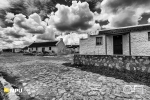
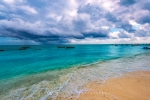
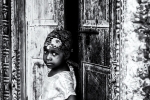
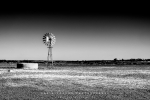


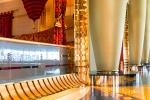

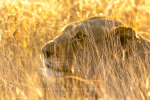
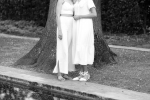


By Rafael Pons
Here is a very informative guide by the guys at PhotoPills, who, as far as I am concerned are the industry standard for astrophotography apps. All credits in this blog belong to the authors, none of these works are mine. Their guides are very helpful,so be sure to enter your valid email address to receive one.
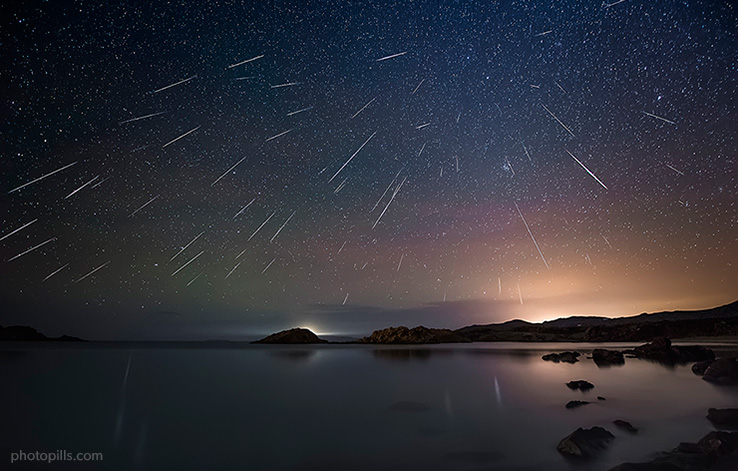
You’re about to learn all you need to enjoy watching and shooting one of the best late-night shows served by nature: Meteor Showers.
Meteors are caused by streams of cosmic debris entering the Earth’s atmosphere at extremely high speeds. Smaller fragments burn in the atmosphere producing a “shooting star”, but the bigger ones can really produce an amazing big fireball.
And when the space rocks (meteoroids) of the Perseids, the Geminids or any other powerful meteor shower enter Earth’s atmosphere, you’d better be ready for a great night of shooting stars.
My goal with this article, using the same words that the night photography Master Lance Keimig uses in his most famous book, Night Photography and Light Painting, is to help you:
“Find your way in the dark”
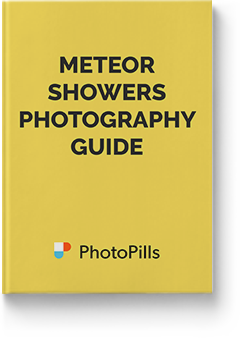
The following table gives you all the key information about the most important and active meteor showers in 2018:

Pay attention to the Moon phase percentage during the peak night. The more phase the worst conditions for the watching and shooting.
As you see on the table, moonlight will be blocking the Quadrantids, Eta Aquariids, Delta Aquariids and Orionids. While, the conditions will be great for the Lyrids, Perseids, Leonids and Geminids.
Finally, the table also provides both the Radiant and constellation of origin of each meteor shower to help you know where to look or frame your camera.
During the meteor shower, you’ll observe that meteors radiate from one point in the night sky. This spot is called the radiant.
Each radiant (the point of origin from where the meteors appear to converge) is located within or near the constellation that give the name to the meteor shower.
For example, the radiant of the Geminids meteor shower is located in the constellation of Gemini, near the Castor star, one of the brightest stars in the night sky.
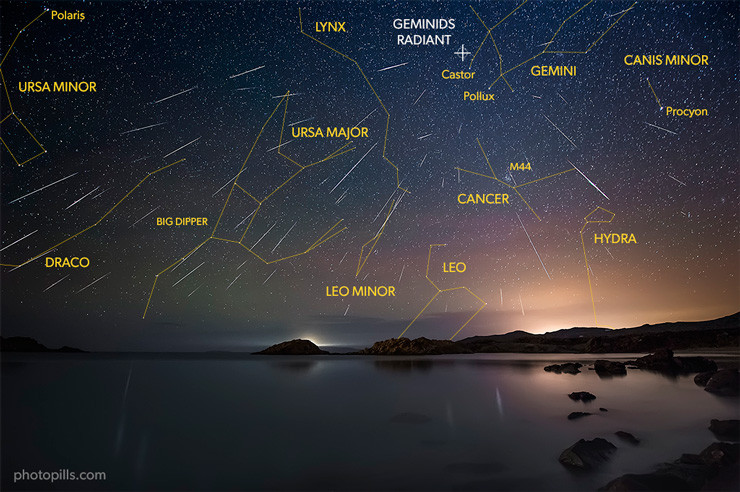
But you don’t have to look in the direction of the meteor shower’s radiant point to see the most meteors. Meteors can appear in all parts of the sky.
If you decide to introduce the radiant point in your frame and trace the path of the meteors backwards, you’ll realize that all meteors appear to converge to one single spot in the sky.
In this case, if you’re lucky enough to capture many meteors, you can create a stunning effect by using the technique described in this video by David Kingham for image post-processing.
By using David’s technique, Antoni Cladera (aka, the Photographer) could built the awesome cover image of this article. I love this effect.
How can you locate the radiant?
The position of the radiant in the sky is defined by two coordinates: Right Ascension and Declination.
Yes, I know, both coordinates have horrible names and even worse definitions. The good news is that you don’t need to understand the theory to use PhotoPills’ Night Augmented Reality tool to locate the exact position of the radiant in the sky given by Right Ascension and Declination. Take a look at the following video to learn how to do it. We help you locate the radiant of the Perseids (Right ascension 3h 4m, Declination +58º). It’s easier that it seems, I promise 😉
Once you’ve located the radiant in the sky for both the beginning and the end of the shooting, you’ll know exactly the path the radiant will follow. Then, you’ll be able to frame at the right area of the sky to create an image with the same effect than David Kingham’s.

The Quadrantids, well known for their bright fireball meteors, which produce larger explosions of light and color, are also known to be tricky.
With a Zenithal Hourly Rate (ZHR) reaching 120 meteors per hour, the Quadrantids could be the most powerful shower of the year. But it turns out that the peak only lasts a few hours, which makes it difficult to catch.
The shower runs from January 1 to 6. The best night for the watching is the one between the 3 and 4. The Peak has been predicted for January 3 at 20h UTC.
This is not a good year for the Quadrantids, the Moon, with a phase of 98%, will block the stars.
Unfortunately, this meteor shower is only visible from the northern hemisphere. These meteors are not visible from the southern hemisphere.
Highlights:

With a Zenithal Hourly Rate (ZHR) of just 20 meteors per hour, the Lyrids is an average shower. It runs from April 16 to 25. The best night for the watching is the one between the 22 and 23. The Peak has been predicted for April 22 at 18h UTC.
This year, the crescent Moon will allow us to enjoy the show.
This meteor shower is visible from both hemispheres. Although it’s weaker in the southern hemisphere.
Highlights:

The Eta Aquariids is known for its high percentage of persistent trains, but few fireballs. It’s usually a very active meteor shower when viewed from the southern tropics. Its Zenithal Hourly Rate (ZHR) is 55 meteors per hour, but it gets down to 10-30 from the equator northward.
It runs from April 19 to May 25. The best night for the watching is the one between May 6 and 7. The Peak has been predicted for May 6 at 8h UTC. Trying the night before and after is also a great idea.
The Moon, with a phase of 61%, will be an issue this year. It might block part of the meteors. So, use PhotoPills to check the time the moon will set in your location and get ready for the show. You never know what can happen!
The meteor shower is best visible from the southern hemisphere. It’s also visible from the northern hemisphere but at a lower rate.
Highlights:

As it happens with the Eta Aquariids, it’s better to watch this shower from the southern tropics. With a Zenithal Hourly Rate (ZHR) of 20 meteors per hour, do not expect to see many meteors.
It runs from July 12 to August 23. The best night for the watching is the one between July 29 and 30. The Peak has been predicted for July 30 at 11h UTC.
This is not a good ear for the Eta Aquariids, the Moon, with a phase of 96%, will block the stars. The meteor shower is best visible from the southern hemisphere. But it’s also also visible from the northern hemisphere but at a lower rate.
Highlights:

The Perseids is considered to be the best meteor shower of the year. With a Zenithal Hourly Rate (ZHR) of above 100 meteors per hour, the night of the peak is usually epic. It runs from July 17 to August 24.
This year, the best night for the watching is the one between the 12 and 13 of August. The Peak has been predicted for August 13 at 01h UTC. It’s a good idea to give it a try also the nights between the 11-12 and 13-14.
The moon, with a phase of 3%, will give us the opportunity to enjoy a big show. The meteor shower is visible and intense in both hemispheres.
Highlights:

The Orionids are associated to the comet 1P/Halley, the same that’s associated to the Eta Aquariids in May. It’s an average shower with a Zenithal Hourly Rate (ZHR) of just 20 meteors per hour.
It runs from October 4 to November 14. The best night for the watching is the one between the 21 and 22 of October. The Peak has been predicted for October 22 at 03h UTC.
Unfortunately, the moon, with a phase of 91%, will block the stars. The meteor shower is visible in both hemispheres.
Highlights:

The Leonids has a peak above 100 meteors/hour every 33 years. The last great peak occurred in 2001, so we’ll have to wait until 2034! Usually, It’s an average shower with a Zenithal Hourly Rate (ZHR) of just 15 meteors per hour.
It runs from November 5 to 30. The best night for the watching is the one between the 17 and 18 of November. The Peak has been predicted for November 17 at 23h UTC.
The Moon, with a phase of 62%, will be an issue this year. It might block part of the meteors. So, use PhotoPills to check the time the Moon will set in your location and get ready for the show.
The meteor shower should be visible in both hemispheres.
Highlights:

For many astronomers, the Geminids is considered to be the queen of the meteor showers. The comet 3200 Phaethon is the cause of this meteor shower. With a Zenithal Hourly Rate (ZHR) of +120 meteors per hour, you can expect to see a good number of bright meteors.
It runs from December 4 to 16. The best night for the watching is the one between the 13 and 14. The Peak has been predicted for December 14 at 13h UTC.
This year, the waxing crescent Moon will not be a problem for the watching. Use PhotoPills to check the rise and set times, and choose the best time for the shooting.
It’s visible from both hemispheres. Although it’s weaker in the southern hemisphere.
Highlights:
In case you plan a night scape to shoot one of the meteor showers, the following recommendations will help you get started with the shooting:

Regarding the equipment, in Step 7 of our tutorial “How to Shoot Truly Contagious Milky Way Pictures”, you’ll find all you need no matter your level of expertise or budget. Make sure to take a look at it.
But, knowing the camera, lens and tripod you’ll need is only the beginning. I recommend you to also bring with you at least one heater strip to fight dew back!
One of the most annoying aspects of night photography is dealing with dew. Moisture in the air can condense on the cold front surface of your lens, and ruin the photos. Getting a heater strip is a great way to save the night. The good news is that heater strips are very cheap (see again “Equipment against moisture” in step 7).
Perhaps, the two most popular heater strip brands are Dew-Not and Kendrick. I use a Dew-Not 3″ DN004, which perfectly fits my Nikon 14-24mm f/2.8. This model has a length of 13″ (33cm), enough for the diameter of the lens. Make sure you buy a strip that can go around the entire circumference of the lens. You’ll also need a portable battery and a cable connector.

Need more help? Take a look at our articles How To Shoot Truly Contagious Milky Way Pictures and The Definitve Guide to Shooting Hipnotic Star Trails. You’ll learn everything you need to imagine, plan and shoot stunning photos of the stars.
And if you wish to learn face to face with us, the whole PhotoPills Team, along with a selected group of photography masters, don’t miss the PhotoPills Camp!
From stacking a great number of photos to create David Kingham’s effect or a powerful star trails image, to putting together a timelapse video, spending the whole night shooting a meteor shower can be very productive from the creative side.
The following images and videos are the outcome of the Geminids Meteor shower in 2015.
It was on Monday, December 14 2015, around 10pm local time, when the clouds disappeared from above our heads, leaving us face to face with one of the most active meteor showers we remember.
We spent the next 5 hours shooting and enjoying the show. What an epic time!
The timelapse is the result of playing 647 still images at 24fps. Nikon D4s | 14mm | f2.8 | 30s | 5000 ISO
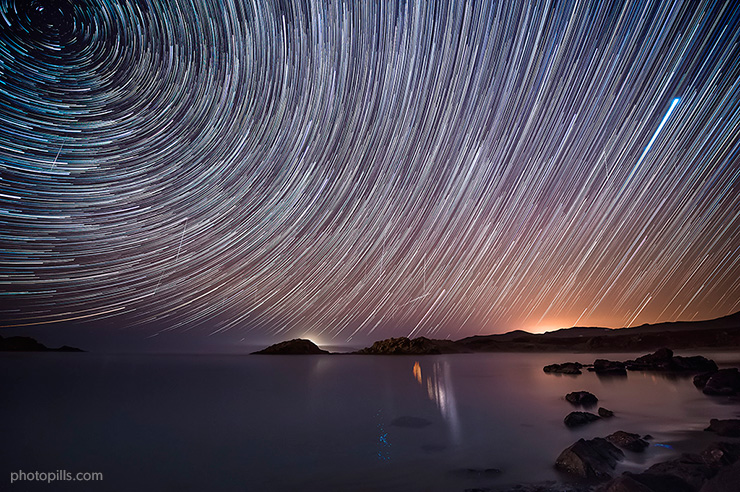
You can create stunning star trails by merging a series of short exposure photos into a single image using softwares like StarStaX (Mac, Windows, Linux) or Startrails (Windows).
Who has seen the explosion of a meteor in the sky? We did! And with a smoky tail 🙂
You never know what your camera will capture during the night. Each night scape is a different adventure.
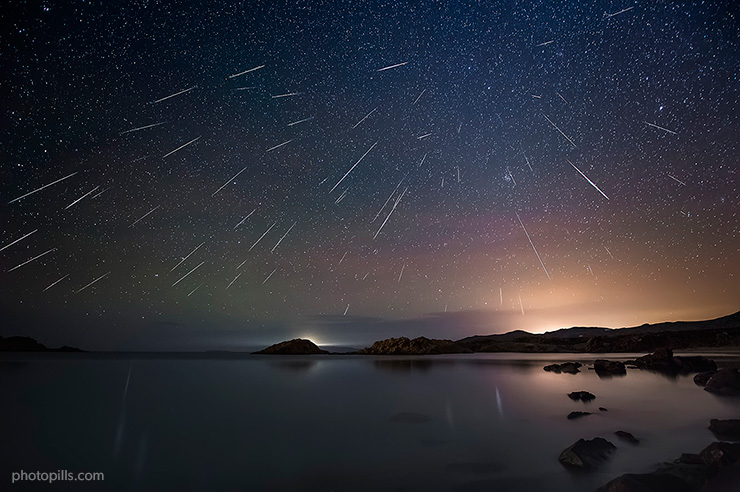
The image is the result of stacking 120 photos using David Kingham’s technique. To create this stunning effect, every photo has been rotated around Polaris to keep the radiant point of the meteor shower in the same place. This proves that all meteors appear to converge from one single point in the sky: the radiant.
Happy Showers!
All photos in this articles have been taken by Antoni Cladera.
Please subscribe to my free monthly NO-SPAM newsletter which will inform you of any new workshops, activities, products and upcoming events.
SUBSCRIBEI am a Western Cape Winelands photographer based in South Africa, photographing locally and internationally. I am a registered NPS (Nikon Professional Services) member, a contributor to Nikon South Africa's social media pages and website. I photograph a broad variety of genres, using film - 35mm, 120, 127 and 4x5" 4x10, 5x7" & 8x10" format as well as digital medium and are very passionate about my work.
My work has been published in various South African newspapers and magazines including Atlantic Gull Magazine with a cover, SA4x4, HIGH LIFE (British Airways Magazine), Getaway Magazine, Wildside Magazine and Weg!/go! Magazine. I finished as a Top Ten finalist in the 2016 Getaway Magazine Gallery Competition, finishing with Highly Commended. The South-African national news broadcaster eNCA has also made use of video footage that I have produced.
Please feel free to comment and share. You can also click on the social media buttons in the footer below and see what I am currently doing, or sign up for my newsletter and follow me.
Until next time, thanks for your support, appreciating my work and reading my blogs.
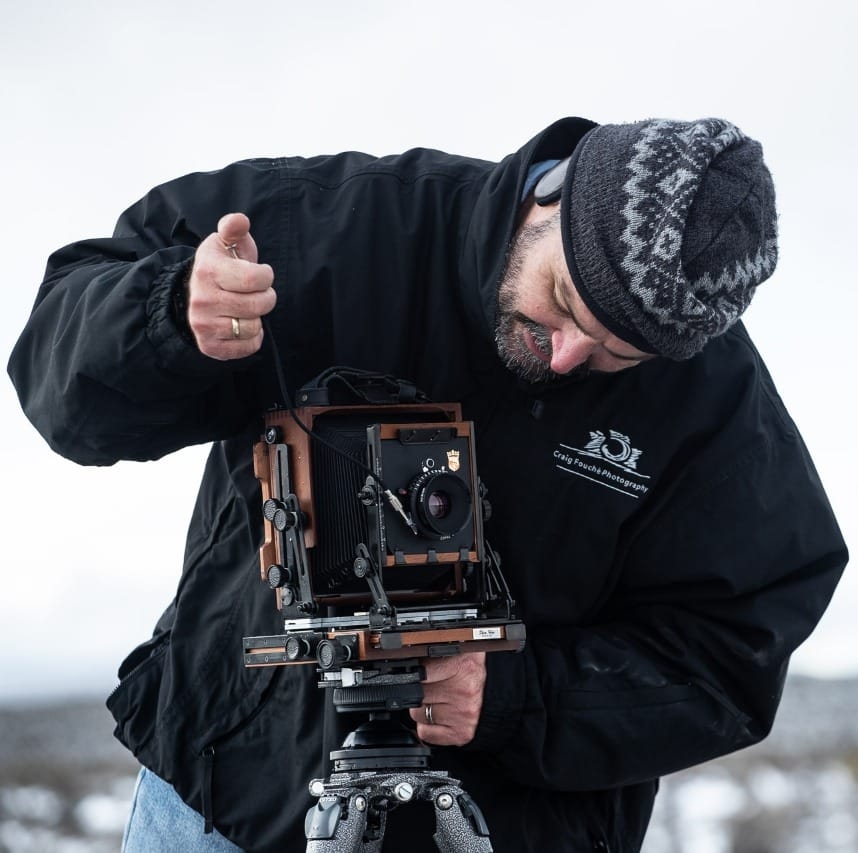
Craig Fouché, Rogge Cloof, Sutherland, South-Africa ©2020 Kirsten Frost Photography